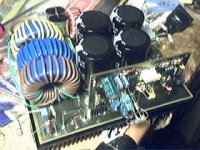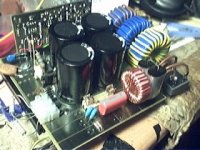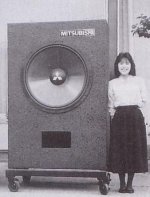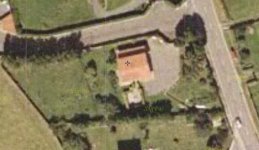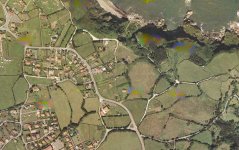Eva said:...but I think that the switching mode audio technology is not yet mature enough...
I couldn't agree with you more. Ten years from now, I doubt we would even be having this discussion.
Ok Eva
Are you seated?
Let me say this loud and clear for the last time:
I don’t hate switching mode electronics!!!

Concerning your comments about your EX4000.
The PowerLight model as roughly the some topology but weights half due to switched PSU.
However their behaviour is exactly the same you describe:
They are no difference. I have investigated further and the SMPS looks like transferring the ripple from secondary to primary.
As simple as that.
Considering also that the audio loudspeaker circuit is closed in the secondary capacitors, is not a surprise that the sound in bass frequencies is a “little strange”. (I know that it is not very scientific statement and you could ignore it)
http://www.qscaudio.com/support/library/schems/Current/PowerLight Series/pl40.pdf page 2 only 3x470uF per rail.
Yes I know that the capacitors are charged 200K times per second, but don’t forget that they also pass the audio power signal…
I know, I know… is just a matter of increase the size of primary and secondary capacitors and this amplifier probably will sound as your bigger one…
Are you seated?

Let me say this loud and clear for the last time:
I don’t hate switching mode electronics!!!


Concerning your comments about your EX4000.
The PowerLight model as roughly the some topology but weights half due to switched PSU.
However their behaviour is exactly the same you describe:
Eva said:
“the rails sagging badly from 145V down to 100V under 4 ohm heavy use and a real-world 205V sagging mains supply...
They are no difference. I have investigated further and the SMPS looks like transferring the ripple from secondary to primary.
As simple as that.
Considering also that the audio loudspeaker circuit is closed in the secondary capacitors, is not a surprise that the sound in bass frequencies is a “little strange”. (I know that it is not very scientific statement and you could ignore it)
http://www.qscaudio.com/support/library/schems/Current/PowerLight Series/pl40.pdf page 2 only 3x470uF per rail.
Yes I know that the capacitors are charged 200K times per second, but don’t forget that they also pass the audio power signal…
I know, I know… is just a matter of increase the size of primary and secondary capacitors and this amplifier probably will sound as your bigger one…
I don't like those first generation QSC SMPS at all, they barely replaced the 50Hz iron by 50Khz ferrite, but without improving performance or reliability. My preferred SMPS topology is regulated with plenty of secondary side storage capacitance and continuous (stable) current limiting, not sized to supply the full rated power, but capable of reducing the output voltage in case of overload so that the thing continues happily working.
For example I have developed a high power PFC stage that works that way, you can overload it as much as you want but the transistors, diodes and coils are inherently protected and will never pass more than 35A peak. It can work continuously into current limiting without problem, which is the main advantage of switching mode. It outpus 416V DC pseudo-regulated, 4.8KW with 230V AC input before starting to fold back... still 2.5KW at 120V AC. Efficiency is 96% or so...
Screwdriver load may be considered normal working conditions for any well engineered SMPS 😀😀
For example I have developed a high power PFC stage that works that way, you can overload it as much as you want but the transistors, diodes and coils are inherently protected and will never pass more than 35A peak. It can work continuously into current limiting without problem, which is the main advantage of switching mode. It outpus 416V DC pseudo-regulated, 4.8KW with 230V AC input before starting to fold back... still 2.5KW at 120V AC. Efficiency is 96% or so...
Screwdriver load may be considered normal working conditions for any well engineered SMPS 😀😀
Your description makes me dream... is exactly that I need for my new self powered sub-woofer beast.
It’s a shame the 145dB internal pressure.
Hmm.. I thought that the shake could induce false trigger in your controller? 😀 😀
It’s a shame the 145dB internal pressure.
Hmm.. I thought that the shake could induce false trigger in your controller? 😀 😀
The people who think that for driving Subwoofers one must have HEAVIER amplifiers are nothing less than Non-Sense creatures crawling on the face of earth.....[A general view only]
Here are some new lightweight amps
8KW Class-D by QSC
http://www.qscaudio.com/products/amps/powerlight3/powerlight3_feature.htm
http://www.qscaudio.com/products/amps/powerlight3/powerlight3.htm
6.8KW Class-D by Ecler[reverse engineered by my friend]
http://www.ecler.es/EN/product.asp?ProductID=45
6.4KW Class-D by Hotsound Pro
http://www.hotsound.com.br/digilite64_modelos.asp?menu=Série Digilite
There's an exception exists....😀 😉
here is a link to 4KW Class-AB 3U rack space 34Kg "Weighted" amp
http://www.ecler.es/EN/product.asp?ProductID=66
EVITA, Your smps looks damn sexy!
Are you a Superwoman..🙂
Here are some new lightweight amps
8KW Class-D by QSC
http://www.qscaudio.com/products/amps/powerlight3/powerlight3_feature.htm
http://www.qscaudio.com/products/amps/powerlight3/powerlight3.htm
6.8KW Class-D by Ecler[reverse engineered by my friend]
http://www.ecler.es/EN/product.asp?ProductID=45
6.4KW Class-D by Hotsound Pro
http://www.hotsound.com.br/digilite64_modelos.asp?menu=Série Digilite
Originally posted by Evita
TOINO's statements seem quite hard to believe to me too.
A 30Kg purely linear stereo "oldschool" amplifier, without rail switching or switchmode stuff, will require 4U of rack space and may produce 500/800/1000Wrms (continuous) into 8/4/2 ohms at best, and another 500/800/1000W of heat during normal use, something hard to deal with when you get a bunch of those amplifiers stacked in a rack. Not to mention the weight of the rack when it comes to move it in and out of the truck/plane and pay the fuel...
There's an exception exists....😀 😉
here is a link to 4KW Class-AB 3U rack space 34Kg "Weighted" amp
http://www.ecler.es/EN/product.asp?ProductID=66
EVITA, Your smps looks damn sexy!
Are you a Superwoman..🙂
TOINO said:Hmm... I see... people like me
And what about this one?
You still haven't disclosed the specs of your 30Kg Reference Weighted amp.......

Take any of the above mentioned lightweight amps to drive that monster sub and cheer up the girl....and do took her to party also...😀
Workhorse said:Are you a Superwoman
By the looks of the pics she is, Eva is not likely to haunt you to clean up your creative product workbench.
Eva said:You could actually see me and my workbench in this picture... 😀😀😀
I Think we need X-Rated glasses to see superwoman Evita😀 😀 😉
one more smps
An externally hosted image should be here but it was not working when we last tested it.
I don't like those first generation QSC SMPS at all, they barely replaced the 50Hz iron by 50Khz ferrite, but without improving performance or reliability.
Workhorse
The picture you have posted show enough details to conclude that this is one of the kind of above posts.

As an ignorant, it seems to me that the solution will be “active ripple filtering” in primary and bigger capacitors on secondary.
Something thing like Eva’s PFC in front-end, followed by that thing.
With the actual component size, it will be much bigger than the today commercial proposals in the market.
Eva
I have tried hard but I couldn’t found you…
Could you show it on a smaller scale?...
TOINO said:
Workhorse
The picture you have posted show enough details to conclude that this is one of the kind of above posts.
As an ignorant, it seems to me that the solution will be “active ripple filtering” in primary and bigger capacitors on secondary.
Something thing like Eva’s PFC in front-end, followed by that thing.
With the actual component size, it will be much bigger than the today commercial proposals in the market.
You want to start a new pro-smps revolution Toino, GO GO GO! 😀 😉
I have seen various commercial amps with PFC frontend + Quasi resonant mode smps...but in case of QSC their Discontinuous resonant mode always failed on poor Gensets...
Workhorse said:
I have seen various commercial amps with PFC frontend + Quasi resonant mode smps...but in case of QSC their Discontinuous resonant mode always failed on poor Gensets...
Welcome to my club.
Yes, I see what you mean with "Discontinuous"
 😀 😀
😀 😀 However before fail, it well shakes the loudspeakers!
Because of that, I suspect that is the way.
But, as I said, is big and heavy.(3U-24Kg)
Eva
Concerning your PFC project, could you provide me (through my forum contact) an email address with more than 300Kb capacity?
I have a document that should be of your interest.
Concerning your PFC project, could you provide me (through my forum contact) an email address with more than 300Kb capacity?
I have a document that should be of your interest.
- Status
- Not open for further replies.
- Home
- Amplifiers
- Solid State
- LabGruppen, what to do?
